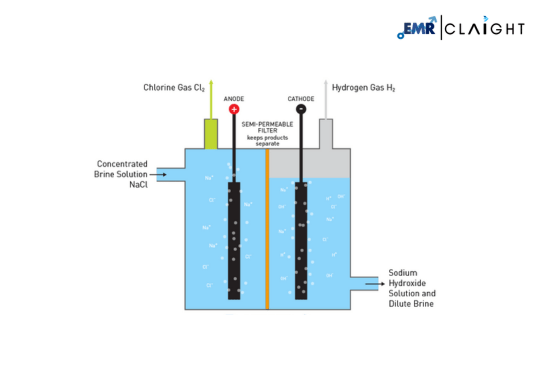The chlor-alkali market is poised for stable growth driven by strong demand across key end-use industries such as chemicals, textiles, paper and pulp, water treatment, and construction. The market is influenced by the production of chlorine, caustic soda, and hydrogen, which serve as essential raw materials for a wide range of industrial applications. Increasing urbanization, infrastructure development, and rising water sanitation needs further boost market expansion. Technological advancements in membrane cell processes and efforts to reduce environmental impact are shaping production methods. Additionally, regional demand shifts and regulatory frameworks play a crucial role in influencing market dynamics and investment trends.
Chlor Alkali Market Size and Growth
The global chlor-alkali market size attained a volume of 93.58 million metric tons (MMT) in 2024, reflecting its significant role in supplying essential chemicals such as chlorine, caustic soda, and hydrogen. These products are widely used across industries including water treatment, textiles, paper and pulp, and construction. The market's robust base is driven by industrialization, population growth, and the rising need for clean water and sanitation.
Looking ahead, the market is projected to grow at a compound annual growth rate (CAGR) of 4.50% from 2025 to 2034, reaching a volume of 145.33 MMT by 2034. This growth will be supported by ongoing urban development, increasing demand for PVC in construction, and technological advancements in chlor-alkali production processes. Environmental regulations and energy efficiency initiatives are also expected to shape industry dynamics, encouraging the adoption of more sustainable manufacturing technologies.
Chlor Alkali Market Trends
The chlor-alkali market is witnessing several key trends that are shaping its evolution:
Explore Key Insights with a Free Sample Report
1. Shift to Membrane Cell Technology: There is a strong move away from mercury and diaphragm cell technologies toward more energy-efficient and environmentally friendly membrane cell processes, driven by regulatory pressures and sustainability goals.
2. Rising Demand for PVC: The construction and automotive sectors are fueling increased demand for polyvinyl chloride (PVC), which relies heavily on chlorine, one of the key chlor-alkali products.
3. Water Treatment Growth: With growing global concerns over clean water access, demand for caustic soda in water treatment and sanitation applications is on the rise.
4. Expansion in Emerging Markets: Rapid industrialization in countries across Asia-Pacific, Latin America, and Africa is spurring demand for chlor-alkali products, encouraging capacity expansions and investments in these regions.
5. Digitalization and Automation: Industry players are adopting digital tools and process automation to enhance efficiency, reduce downtime, and monitor environmental compliance.
6. Circular Economy Initiatives: Sustainability trends are pushing companies to explore recycling of chemicals and reduction of waste in chlor-alkali production processes.
Market Opportunities and Challenges
Opportunities
1. Growing Industrial Applications: Expanding use of chlorine and caustic soda in industries like paper & pulp, textiles, water treatment, and chemicals offers strong growth potential.
2. Infrastructure and Construction Boom: Rising demand for PVC in infrastructure development boosts the need for chlorine, driving market expansion.
3. Emerging Markets: Rapid industrialization in Asia-Pacific, Africa, and Latin America presents opportunities for capacity expansion and market penetration.
4. Green Technology Adoption: Transition to membrane cell technology opens new investment avenues with improved energy efficiency and regulatory compliance.
5. Water Treatment Needs: Increasing focus on sanitation and clean water access globally fuels demand for caustic soda.
Challenges
1. Environmental Regulations: Stringent emissions and mercury phase-out regulations raise compliance costs and operational challenges.
2. High Energy Consumption: Chlor-alkali production is energy-intensive, making it vulnerable to fluctuations in energy prices and sustainability concerns.
3. Volatile Raw Material Prices: Fluctuations in the prices of salt, electricity, and other inputs can affect profit margins.
4. Geopolitical Risks and Trade Barriers: Export-import restrictions and geopolitical instability may disrupt supply chains and market access.
5. Waste Management Issues: Handling byproducts like hydrogen and managing brine disposal pose environmental and logistical hurdles.
Chlor Alkali Market Analysis
The chlor-alkali market plays a critical role in the global chemical industry, driven by the widespread demand for chlorine, caustic soda, and hydrogen across sectors such as water treatment, textiles, pulp and paper, and construction. Its performance is closely tied to industrial growth, infrastructure development, and sanitation needs, particularly in emerging economies. Increasing urbanization and expanding applications in PVC manufacturing continue to fuel the consumption of chlor-alkali products.
Technological advancements, especially the shift toward membrane cell technology, are enhancing production efficiency and reducing environmental impact. However, the market faces challenges such as high energy consumption, strict environmental regulations, and raw material price volatility. Companies are increasingly investing in sustainability initiatives and digital transformation to improve competitiveness. With a growing emphasis on water purification and sustainable industrial practices, the market is expected to remain robust, particularly in regions undergoing rapid industrial and infrastructure expansion.
Competitive Landscape
The key players in the industry includes:
Occidental Petroleum Corporation
Olin Corporation
Formosa Plastics Corporation
Akzo Nobel NV
Tosoh Corporation
INOVYN
Genesis Energy, L.P.
Tata Chemicals Ltd.
Ciner Resources Corporation
SHANDONG OCEAN CHEMICAL CO., LTD
Haohua Junhua Group Co., Ltd.
Others
Media Contact
Company Name: Claight Corporation
Email: [email protected]
Toll Free Number: +1-415-325-5166 | +44-702-402-5790
Address: 30 North Gould Street, Sheridan, WY 82801, USA
Website: www.expertmarketresearch.com
